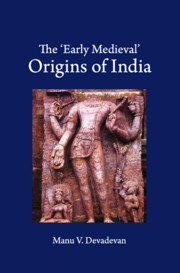Book contents
- Frontmatter
- Dedication
- Contents
- List of Tables
- List of Maps and Figures
- Acknowledgements
- 1 Introduction
- I INSTITUTIONS
- 2 State Formation and Its Structural Foundations
- 3 From the Cult of Chivalry to the Cult of Personality: The Seventh- Century Transformation in Pallava Statecraft
- 4 Changes in Land Relations and the Changing Fortunes of the Cēra State
- 5 Temple and Territory in the Puri Jagannātha Imaginaire
- II IDEAS
- 6 Svayaṃbuddha's Predilections: The Epistemologies of Time and Knowledge
- 7 Bhāravi and the Creation of a Literary Paradigm
- 8 Knowing and Being: The Semantic Universe of the Kūḍiyāṭṭaṃ Theatre
- 9 The Invention of Zero and Its Intellectual Legacy
- III IDENTITIES
- 10 The Evolution of Vernacular Languages: A Case Study of Kannada
- 11 Religious Identities in Times of Indumauḷi's Grief
- 12 Caste, Gender, and the Landed Patriarchy
- 13 The Making of Territorial Self Consciousness (with Particular Reference to Kaliṅga)
- Bibliography
- Index
2 - State Formation and Its Structural Foundations
Published online by Cambridge University Press: 02 May 2020
- Frontmatter
- Dedication
- Contents
- List of Tables
- List of Maps and Figures
- Acknowledgements
- 1 Introduction
- I INSTITUTIONS
- 2 State Formation and Its Structural Foundations
- 3 From the Cult of Chivalry to the Cult of Personality: The Seventh- Century Transformation in Pallava Statecraft
- 4 Changes in Land Relations and the Changing Fortunes of the Cēra State
- 5 Temple and Territory in the Puri Jagannātha Imaginaire
- II IDEAS
- 6 Svayaṃbuddha's Predilections: The Epistemologies of Time and Knowledge
- 7 Bhāravi and the Creation of a Literary Paradigm
- 8 Knowing and Being: The Semantic Universe of the Kūḍiyāṭṭaṃ Theatre
- 9 The Invention of Zero and Its Intellectual Legacy
- III IDENTITIES
- 10 The Evolution of Vernacular Languages: A Case Study of Kannada
- 11 Religious Identities in Times of Indumauḷi's Grief
- 12 Caste, Gender, and the Landed Patriarchy
- 13 The Making of Territorial Self Consciousness (with Particular Reference to Kaliṅga)
- Bibliography
- Index
Summary
Among the institutions that gained roots in India between the sixth and the twelfth centuries, few were as formidable in their power and appeal as the state. Regional and local states appeared in different parts of the subcontinent in great numbers in the course of these centuries to preside over a milieu sustained by an agrarian economy. Inscriptions contain information about several hundred royal families during this period. Many of them succeeded in establishing states. Some of them were formidable in power. The Pallavas, the Cōḻa, and the Pāṇḍyas in the deep south, the Bādāmi Cāḷukyas, the Rāṣṭrakūṭas, and the Kalyāṇa Cāḷukya in southern and central Deccan, the Pālas, the Sēnas, and the Kaliṅga Gaṅgas in eastern India, the Chāndēllas, the Paramāras, and the Tripuri Kalacūris in central India, and the Gāhaḍavālas, the Chāhamānas, and the short-lived state of the family of Harṣa (that we now call the Puṣyabhūti dynasty) in the north are the ones that immediately come to mind. Subordinate houses of lords and chiefs proliferated in even greater numbers, some among them such as the Śilāhāras and the Veṅgi Cāḷukyas wielding authority akin to a state’s, and a few others, like the Bāṇas, throwing up an enviable record of resilience and survival.
The emergence of states was a complex and protracted process that invariably involved conflicts at various levels. The forms in which it found expression were also varied, ranging from the realpolitik of wars and alliances on the one hand to the building of aesthetic infrastructures through the promotion of distinct genres of court poetry and styles of temple architecture on the other. The image of the state that was created in the course of these processes was the one that informed and animated political imagination in India until the advent of democracy a few generations ago.
Historians have characterized this process as the horizontal spread of the state as an institution, ‘implying the transformation of pre-state polities into state polities’. We must hasten to add that this was not marked by uniformity in terms of antiquity, evolution, levels of development, and forms of organization. Some parts of the subcontinent had a long history of state formation, dating back to the sixth century BCE. Regions in the mid Gaṅgā valley belong to this class.
- Type
- Chapter
- Information
- The ‘Early Medieval' Origins of India , pp. 29 - 88Publisher: Cambridge University PressPrint publication year: 2020



